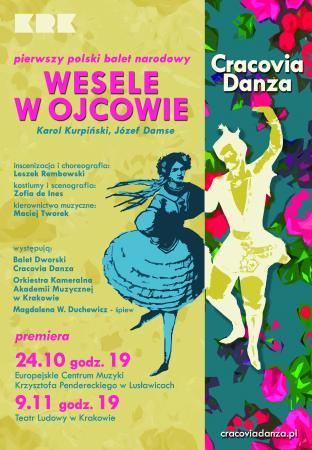
Na zdjęciu: Xavier Le Roy „Untitled”. Fot. Jamie North - Kaldor Public Art Projects.
On Saturday, 24 October (7 pm), the Cracovia Danza Court Ballet and the Krzysztof Penderecki European Centre for Music (Lusławice 250) will present the premiere of Poland?s earliest national ballet work, Karol Kurpiński and Józef Damse?s Wesele w Ojcowie [Wedding in Ojców]. Choreographed by Leszek Rembowski, the piece will be performed by the Chamber Orchestra of the Academy of Music in Cracow conducted by Maciej Tworek. Having specialized in historical dance for years, Cracovia Danza cultivates Polish dance traditions and promotes it abroad. This will be the company?s first crack at classic ballet repertoire, accompanied by traditional wedding songs performed in an archaic manner by Magdalena Wieczorek-Duchewicz.
A repeat performance will be staged on 9 November at the Ludowy Theatre in Cracow. The Lusławice premiere will be preceded by a meeting with choreographer Leszek Rembowski, devoted to the problems of Polish dances (organized as part of the Czas na taniec! [Time to dance!] cycle) on 20 October (8 pm).
***
A dance account of a wedding in Ojców near Cracow was originally a pretext for a presentation of Polish tradition. Premiering in 1823 at the Narodowy Theatre in Warsaw, the performance became a display of Polishness. The premiere was choreographed by Maurice Pion and Warsaw-based ballet mistress Julia Mierzyńska, who performed the work?s highlight solo mazur. The ballet became an instant sensation and was staged over 400 times in Warsaw alone by the end of the century.
Such was the popularity of Wedding in Ojców that individual excerpts became ball room staples, with numerous indications of the work?s ?impact on the formation of sleigh ride and Shrovetide masquerades, the so-called Cracow weddings, which quickly gained favour with Polish gentry and no doubt contributed to the rising popularity of the krakowiak dance throughout the former Polish-Lithuanian Commonwealth,? argues dr Tomasz Nowak, musicologist at the University of Warsaw. These festivities were also described by Oskar Kolberg, the founding father of Polish ethnography.
In 1851, the Narodowy Theatre company took Wesele in Ojców to Saint Petersburg, leaving the Russian critics and audiences enchanted with the piece. Polish national dances conquered Russia thanks to their liveliness and temperamental performances by Warsaw dancers. 1911 saw the renewal of the ballet, which was featured in the Teatr Wielki repertoire throughout the interwar period. At the time, the piece was also presented in Poznań, Katowice, New York, Saint Petersburg and in Côte d’Azure. The ballet was frequently expanded to include other compositions. Following World War II, Polish theatres took up Wesele in Ojców several times, and after 1989 the ballet?s popularity dwindled ? the sole staging of Wesele in Ojców was delivered by the ?Mazowsze? folk song and dance ensemble, and excerpts from its music were presented in concerts in several venues in the country. The last such performance was in 2011 at the Warsaw Philharmonic Hall. Four years later, the Cracovia Danza Court Ballet presents the piece once more in all its glory.
Agnieszka Malatyńska-Stankiewicz
Cracovia Danza impresario
Karol Kurpiński, Józef Damse
Wedding in Ojców
Poland?s first national ballet
Direction and choreography: Leszek Rembowski
Assistant choreographer: Dariusz Brojek
Costumes and stage design: Zofia de Ines
Conductor: Maciej Tworek
performers:
Cracovia Danza Court Ballet
Chamber Orchestra of the Academy of Music in Cracow
Magdalena Wieczorek-Duchewicz – vocals
***
Organisers: Ardente Sole Foundation, Cracovia Danza Court Ballet
Co-organisers: Academy of Music in Cracow, Krzysztof Penderecki European Centre for Music in Lusławice
Supported by the Małopolskie Province.
Co-financed by the Cracow Municipal Commune.
Wedding in Ojców has been produced in cooperation with the Institute of Music and Dance within the programme Choreographic Commissions 2015.
